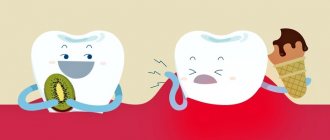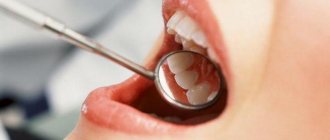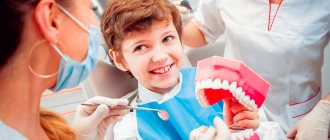Tobacco smoking is a bad habit that has a negative impact on many organs and systems.
First, cigarette smoke enters the oral cavity and affects the human dental apparatus, as well as the soft tissues of the mouth. The consequences of long-term smoking include the formation of unaesthetic plaque, the development of a number of diseases, and poor recovery after dental procedures. The St. Petersburg dental clinic “Nurimed” offers assistance in cleaning teeth from smoking Experienced dentists will take on cases of any complexity and severity. You can sign up for a consultation by calling +7 or by contacting the administrators via online chat.
How does smoking affect teeth?
Tobacco smoke contains a large number of toxic substances harmful to the body. Almost all of them negatively affect the condition of the dentition. Main smoke components:
- nicotine;
- carbon monoxide;
- hydrocyanic acid;
- carbonic acid;
- benzene compounds;
- various oxides;
- hydrogen sulfide;
- acetone;
- carcinogenic substances;
- aldehyde compounds and some other substances in small concentrations.
The first thing that affects a smoker’s teeth is hot smoke, which has a negative effect on tooth enamel. Then toxic substances settle in the oral cavity, causing a traumatic effect.
Why is tobacco considered harmful to the oral cavity?
For a long time, smoking was considered completely natural and safe, in fact, some experts even recommended tobacco to (supposedly) improve blood circulation and lung function. Everyone smoked: from ordinary peasants and workers to prominent politicians and movie stars of the first magnitude. The aestheticization of smoking was largely due to high-profile advertising campaigns and the activity of large corporations that could afford to spend millions to promote their products.
Experts spoke about the dangers of smoking in the 19th and early 20th centuries, but few listened to them. It was only in the second half of the twentieth century that the rise of diseases associated with excessive tobacco use and published research helped put the situation into perspective. Dentists were among those who drew attention to the dangers of smoking. Many studies have been conducted that have proven that smoking is one of the factors that provoke caries, periodontal inflammation and a number of other dental diseases.
Cigarettes contain hundreds of substances and components harmful to the oral cavity: nicotine, carcinogens, acetone, hydrocyanic acid, etc. “Smoker's teeth” have become one of the most common informal diagnoses in dentistry. This was also due to the fact that regular tobacco consumption was complemented by poor hygiene, poor diet and neglect of dental treatment. Someone will object and say that many smokers have completely healthy teeth and sometimes even a snow-white smile. This only means that a person makes great efforts to maintain dental health and has good genes, but in general this bad habit negatively affects the condition of the oral cavity and can still lead to problems and complications later.
Condition of teeth in a smoker
The dentition of a smoker has characteristic changes that occur with prolonged use of cigarettes in large quantities:
- Formation of tartar containing tobacco combustion products in large quantities.
- The gums become looser, which leads to the gradual progressive formation of periodontal pockets. Food debris accumulates in these cavities, increasing the risk of developing an infectious process.
- The effect of smoking on teeth is the severe destruction of enamel, which begins with microscopic damage and ends with deep cracks.
- Gradual destruction of the tooth from the inside. In advanced cases, pieces may break off when chewing solid food.
- Reducing the size of crowns and expanding the distances between them due to sedimentation of the mucous membrane. Gradual loosening of teeth followed by their loss.
Gradual damage to the dentofacial apparatus progresses and spreads beyond the oral cavity, affecting the larynx.
Removing smoker's plaque
To remove smoker's plaque, you will need to have your teeth cleaned at a dental clinic. It should include:
- elimination of tartar using ultrasound (scaling);
- cleaning teeth from soft deposits using an Air-flow sandblaster;
- polishing the enamel surface with a special paste;
- coating of teeth with a fluoride-containing preparation.
According to patient reviews, removing smoker's plaque through such manipulations makes the teeth smooth and resistant to the formation of new deposits. The result can be seen in the photo before and after the procedure.
In some cases, mechanical cleaning alone may not be enough, and then the smoker’s plaque is removed using bleaching. But if the patient has carious cavities and gum disease, they are contraindications to the procedure. To eliminate them, preliminary sanitation of the oral cavity is necessary.
Why do smokers get toothache?
The destructive effect on tooth enamel leads to toothache from smoking . The mechanism of pain is associated with several factors:
- increased overall sensitivity due to thinning of the enamel;
- inflammation of the gums due to the penetration of bacteria;
- development of pulpitis (inflammation affecting the root).
Increased sensitivity leads to the fact that a person feels pain when eating foods that are too cold or hot, sweet, sour, or overly spicy foods. Gradually, the situation worsens, then any impact on the damaged enamel begins to cause pain.
How does smoking affect your gums?
The effect of smoking on teeth includes pathological processes in the soft tissues of the oral cavity. Tobacco smoke causes narrowing of small vessels - capillaries in the gums. Because of this, they become pale and are poorly supplied with oxygen and nutrients. An inflammatory process gradually develops, which may be accompanied by:
- bleeding;
- itching;
- purulent discharge;
- bad breath;
- pain and redness of the gums;
- swelling of soft tissues.
The condition progresses, causing teeth to become loose, even if they are not affected by caries.
Negative effects of smoking
Smoking destroys teeth
The health of teeth and gums will gradually deteriorate as harmful components accumulate. First, in about the first two years, the enamel will turn yellow and microcracks will appear.
This is a favorable environment for microbes, so your breath will smell, to put it mildly, not fresh even a short time after brushing your teeth. Subsequently, depending on the immune system and individual characteristics of the body, various diseases will gradually begin to develop, the most dangerous of which is squamous cell carcinoma.
Therefore, it is important to understand that the price paid for a pack of cigarettes in certain cases can be equal to a human life. The table below shows the main negative consequences of regular oral hygiene with tobacco smoke.
Table. Harm of smoking to teeth:
| Pathology | A comment |
| Cadmium sulfate is deposited on top of the enamel, which is formed after contact of smoke and protein components contained in saliva. As a rule, it first appears on the inner surface of the lower teeth, but then the upper ones also turn yellow, then the lips and mucous membranes of the mouth. |
| An unpleasant odor is the result of the accumulation of combustion products in saliva and various parts of the oral cavity, as well as sulfurous secretions of bacteria. Hot smoke dries the mucous membranes and inhibits the activity of the salivary glands. This leads to xerostomia. Such processes are practically irreversible, and a person will feel a burning sensation and distortion of taste due to changes in the functioning of the receptors. |
| Inflammation of the gums and bones is not uncommon among smokers. Quite often, pathogenesis occurs without pain and bleeding. The teeth first become loose and then fall out. In this case, therapy will not be effective unless you give up the bad habit. |
| The formation of dark brown pigment spots on the mucous membranes of the mouth and gums. Often there is an unpleasant odor and yellow plaque present in parallel. The danger is that delicate epithelial tissues can be significantly transformed. |
| It is more often registered in older people in the form of a characteristic seal on the lips when a cigarette is smoked to the ground. If lesions form, tissue examination is required to differentiate from cancer. |
| Formed at the beginning of smoking. Symptoms: redness of the palate due to vasodilatation. As you get used to it, the mucous membranes become thicker, and a characteristic white coating forms. This is especially common among pipe and cigar smokers due to inhalation of hotter smoke. |
| The formation of painful white lumps with an uneven surface (observed even in the early stages of smoking) on various parts of the mucous membranes, which is due to the negative effect of nitrosamines inhaled with smoke. This pathology refers to precancerous conditions. |
Note. The risks of developing cancer pathologies are quite high in people who smoke a pack of cigarettes every day, but if they drink a liter or more of alcoholic beverages per week, the likelihood of cancer increases many times over.
How do wounds in the mouths of smokers heal?
The effects of smoking on your teeth and mouth go beyond poor appearance and unpleasant symptoms.
Unfortunately, tobacco smoke also aggravates other oral diseases that are not directly related to it. Any wound surfaces in the mouth take much longer to heal in smokers. The reason lies in the fact that normal regeneration requires a good blood supply. Only competent recommendations from an experienced dentist will help avoid a number of complications associated with this. In advanced cases, there is a high risk of infection and the development of chronic inflammation.
Treatment for stomatitis caused by smoking?
Some people consider stomatitis a companion to smoking and are convinced that it does not need treatment. Unfortunately, this is a dangerous misconception. When the disease passes into the chronic stage, it is complicated by the appearance of ulcers, and this is an excellent soil for the proliferation of pathogens and the development of pathologies.
Therefore, when a problem arises, most of us wonder how to treat stomatitis? First of all, you need to quit smoking, thereby allowing the palate to heal and become covered with healthy tissue. Under no circumstances should you let the situation take its course, do not self-medicate and see a doctor. It is imperative to carry out therapeutic treatment of the gums and sanitation of the oral cavity. You can use topical preparations and various gels.
Make an appointment or consult
Possible oral diseases in smokers
Long-term daily smoking of cigarettes contributes to the occurrence of the following pathological conditions:
- Dark coating. Smoking contributes to the formation of dark brown plaque on the teeth, which cannot be removed on your own. The problem is associated with the deposition of cadmium sulfate on the teeth, which is part of tobacco smoke.
- Gingivitis. An inflammatory process affecting the gums. The most common disease among smokers. Accompanied by bleeding during cleaning, redness and swelling.
- Periodontitis. Inflammation of the soft tissues around the tooth up to the bone, involving it in the process. Pain, even during acute infection, is not as severe as in non-smokers, as is bleeding. That is why the problem is noticed already at the stage of loosening, when it is much more difficult to treat.
- Melanosis. Formation of dark spots on the mucous membranes of the oral cavity.
- Stomatitis caused by nicotine. Inflammation of the oral mucosa with the formation of a whitish coating, swelling of the soft tissues and symptoms of irritation.
- Dry mouth. The syndrome develops due to the effects of smoke on the salivary glands and their dysfunction. The process is irreversible, so a person’s taste gradually changes.
- Leukoplakia. A precancerous condition in which the appearance of mucosal cells changes. A smoker develops white nodules on the lips, inner surface of the cheeks, tongue, and palate.
- Leukokeratosis. Another precancerous disease associated with dysplasia of the epithelium on the lips, at the site of contact with a cigarette.
Quitting smoking and brushing your teeth daily can minimize the likelihood of developing oral diseases. It should be borne in mind that a bad habit not only increases the risk of developing the disease, but also slows down its treatment and leads to complications.
The mechanism of the effect of cigarettes on teeth
Carcinogens and tarry substances released by tobacco during its smoldering settle on the surface of the tongue, gums, and oral mucosa. With each new cigarette, the layer of these substances thickens. Bacterial microflora quickly multiplies underneath it, leading to an inflammatory process.
Important: The number of cigarettes smoked is directly proportional to the risk of developing periodontal disease. According to medical statistics, about 95% of smokers aged 35-45 years experience periodontitis. However, in 90% of them treatment is ineffective. This threatens complete loss of teeth by the age of 70-75.
Cigarette smoke can cause enamel cracking. The healthy microflora of the mouth is disrupted. The oral cavity is affected by toxins released during the combustion of tobacco. Among them:
- Resins.
- Hydrocyanic acid.
- Methane.
- Nicotine.
- Tar.
- Ammonia derivatives.
The raid seems safe only at first glance. In fact, it settles in the deep layers of enamel, in every microcrack, and can even affect the top layer of dentin (the base of the tooth). Bacteria, food, and tar released by tobacco penetrate into small cracks. This is why teeth lose their natural, white tint and it becomes impossible to remove plaque with a toothbrush. The shade of the enamel becomes brown, gray or yellow. Over time, hard-to-remove black deposits form on the dental tissues at the roots of the teeth.
Plaque on teeth from smoking. How to remove?
Almost all smokers develop dark plaque on their teeth, which spoils their smile. You can't get rid of it with a toothbrush. It is necessary to carry out professional whitening, provided there are no contraindications. The clinic uses several techniques:
- Removing tartar and cleaning the surface from plaque using ultrasound.
- Gentle laser whitening that does not affect the enamel.
- Using a special gel that, under the influence of ultraviolet light, breaks down plaque.
Since whitening a smoker’s teeth is not an easy procedure that requires high qualifications and extensive experience, be careful when choosing a clinic.
Do-it-yourself whitening
Since it is necessary to constantly visit the dentist to remove plaque, smokers are trying to find ways to whiten their teeth on their own. Methods that can be found on the Internet can be dangerous, but more often they are simply useless:
- Whitening on your own will not remove plaque between your teeth.
- It is impossible to clean the fissures and grooves in the chewing teeth with a toothbrush and improvised means.
- The gingival area of the tooth also cannot be cleaned without dental instruments.
None of the self-whitening methods will remove plaque trapped in microcracks in the enamel.
Professional dental hygiene can help a smoker. The procedure does not whiten the enamel to ideal levels, but it does remove surface pigments. Hygiene is mandatory before the whitening procedure.
Smoking after dental implantation
Dental implantation is one of the most common prosthetic methods, which allows you to achieve an ideal aesthetic and functional result. There are many reasons why you should give up a bad habit during the procedure and recovery:
- slowing down the rate of healing of wound surfaces after implant installation;
- slower engraftment of the implant in the bone tissue, as well as an increased risk of rejection;
- increased risk of infection and development of pain syndrome;
- negative impact on the appearance and functional properties of the crown after installation.
Smoking harms not only natural teeth, but also artificial crowns, gradually affecting their color. A bad habit causes the structure to serve less than it should. You have to change crowns more often, which are not cheap.
What affects teeth
Comparison of the teeth of a smoker and a person without such a bad habit
Smoking causes your teeth to become noticeably yellow. Resinous substances aggregate so strongly with the enamel that it becomes almost impossible to remove yellow plaque with a simple toothpaste.
The main negative components of tobacco smoke are:
- carbon monoxide;
- nicotine;
- carbonic and hydrocyanic acids;
- oxides;
- benzenes;
- hydrogen sulfide;
- carcinogens;
- acetone;
- aldehydes and other components harmful to health.
The photo below shows how toxic one smoked cigarette is. The video in this article describes in detail the harmful effects of a bad habit on the health of teeth and the body as a whole. Any doctor and even a first-year medical student will name a lot of reasons why it is better to quit smoking tobacco products.
Composition of tobacco smoke when smoking
Dry and hot smoke, full of harmful substances, leads to cracks and ulcerations of the gums, they begin to bleed and hurt. In this case, the risks of infectious infection are tens of times higher than for a person who does not suffer from this bad habit.
When the addiction to cigarettes has recently appeared, then after the formation of a yellow coating, it darkens to light brown shades, and after a certain time, dark spots form at the roots. By this time, the gums become inflamed and bleed.
Their integument becomes delicate, so after each toothbrushing it is easily damaged. After a certain period of time, the gums begin to atrophy, the process can worsen so much that the fixation of the teeth weakens, and they begin to fall out.
Smoking after tooth extraction
Modern dentistry offers effective and painless methods of tooth extraction. Patients do not experience any discomfort during the procedure, but they are still worried and cannot resist smoking a cigarette after the treatment is completed.
However, dentists believe that smoking and dental health are incompatible things.
Cigarettes after removing affected teeth, especially if we are talking about wisdom teeth, can cause complications. In addition, tobacco smoke has an irritating effect on the wound surface, causing pain and aggravating inflammation. Smokers are advised to abstain from the habit at least in the first day after removal, and better yet, until complete healing.
Preventive actions
The most effective prevention of pathological changes is giving up the bad habit. If this is not possible, then the following recommendations will help reduce the destructive effects of tobacco smoke:
- Careful, daily personal hygiene. It is recommended to brush your teeth after each meal, use dental floss, and mouthwash.
- Preventive examinations at the dentist with professional cleaning, including whitening. You need to visit a doctor 1-2 times a year to remove tartar and plaque and identify inflammation and infection in the early stages.
- If you cannot completely quit smoking, then you need to at least reduce the number of cigarettes you smoke per day. We are talking not only about the condition of the mouth, but also the impact on the entire body as a whole.
Since to restore teeth after smoking , you should choose a trusted clinic. Dentistry "Nurimed" offers services for whitening, removal, restoration, prosthetics and other types of oral treatment for smokers. The center’s specialists will help you regain psychological comfort and physical health, lost due to the effects of smoking on your teeth.
Material and methods
The study consisted of 5 stages. At the 1st stage, 675 men and women aged 12 to 65 years were examined, including 330 non-smokers and 345 smokers. For each patient, the condition of hard tissues, pulp and periodontium in the area of 28 teeth was assessed (wisdom teeth were not taken into account). In total, the condition of hard tissues, pulp and periodontium in the area of 18,900 teeth was examined.
At the 2nd stage, 120 smoking patients were randomly distributed into three groups. These patients underwent PHM, including professional oral hygiene (PG) (using an ultrasonic scaler, rubber heads, a brush with Detartrine polishing paste and strips), training in the technique and regimen of teeth brushing, and the use of Parodontax toothpaste by patients for 2 months. Patients of the 1st group (40 people) additionally underwent application procedures with the remineralizing drug Bifluoride (4 procedures with a break of 3 days). In the 2nd group (40 people), the same measures were carried out, but in addition, the Icon initial caries infiltration system was used as a drug for the treatment of caries in the spot stage. Group 3 (40 people) was the control group. A repeat examination with mandatory diagnosis of the condition of hard tissues using a Diagnodent pen (Kavo) was carried out after 30 and 60 days.
At the 3rd stage, the development and course of caries in smokers was predicted during such regular activities.
At the 4th stage, 30 smokers from group 1 underwent periodically repeated (once every six months) PG measures with the use of Bifluoride applications and correction of individual hygiene with mandatory assessment of the condition of hard tissues for 4 years. At the 5th stage, after 4 years, actual and predicted results were compared.
To assess the development, course, prevention, treatment of caries and its complications in smokers, a Markov model was developed. The entire process, according to this model, is represented as a graph with 10 states (Fig. 1)
.
Rice.
1. Graph of development, prevention and treatment of uncomplicated and complicated dental caries. 1 - intact tooth; 2 - caries in the spot stage; 3 - caries in the defect stage; 4 - filled caries; 5 - recurrent caries; 6 - pulpitis; 7 - filled pulpitis; 8 - periodontitis; 9 - filled periodontitis; 10 - tooth loss. The arcs of the graph correspond to the intensity of transitions, to determine which two special techniques were used [2, 7]. The development of caries and its complications in the group of interest to us was predicted using the Markov model and the well-known MatLab application package.










